The hillside above me is awash in colors. Not just sedimentary hues of iron and manganese, but the Crayola® versions of Whipple pink, Casper white, Sunburst blazing star, and Firecracker red. April’s showers, winter’s snows, even November’s storms have all contributed the key ingredient of moisture to put on this petal-luscious display of May wildflowers.
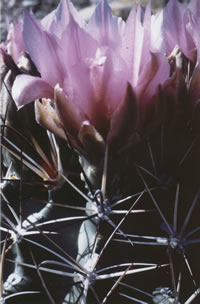 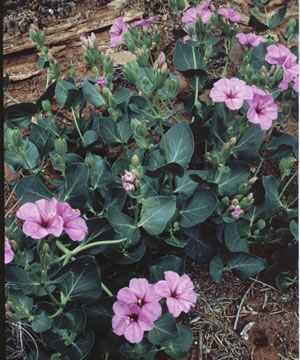
Whipple pink. Excuse me, Mr. Whipple. Not the toilet-paper squeezing guy, but Amiel Wicks Whipple, a Lieutenant of the Topographical Engineers who surveyed a railroad route from the Mississippi River to California along the 35th parallel. More than just a surveyor and West Point graduate, Whipple became a General serving the Union during the Civil War. The small, barrel-shaped Whipple’s fishhook cactus (Sclerocactus whipplei) with the pink flowers honors this explorer. Just don’t squeeze them.
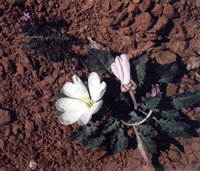 Casper white. I’ve never seen a white ghost, but I have turned a few shades whiter after my ghostly encounters. Who was I gonna call? Maybe it’s too much this starched white that taints my color scheme. But for the white-flowered dwarf evening primrose (Oenothera caespitosa) whose paranormal blossoms light up the night, the color choice seems appropriate. Blooming from late afternoon into the morning hours (definite ghosting times), these sweet-scented flowers are laden with nectar to attract non-ghost-fearing pollinators like the white-lined sphinx moth. Casper white. I’ve never seen a white ghost, but I have turned a few shades whiter after my ghostly encounters. Who was I gonna call? Maybe it’s too much this starched white that taints my color scheme. But for the white-flowered dwarf evening primrose (Oenothera caespitosa) whose paranormal blossoms light up the night, the color choice seems appropriate. Blooming from late afternoon into the morning hours (definite ghosting times), these sweet-scented flowers are laden with nectar to attract non-ghost-fearing pollinators like the white-lined sphinx moth.
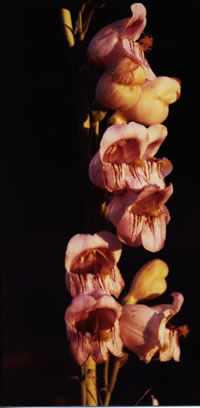 Often confused with their no-relation hummingbird look-alike, the sphinx moth zips around in the evening and uses its long proboscis to extract nectar from deep down within the flower’s throat. Sort of an invertebrate Dracula minus the fangs. At the same time, the flower’s long stamens powder the sphinx moth’s forehead with pollen. At the next nectar stop some of this pollen rubs or falls off onto the flower’s style; hence, the process of pollination has been bought for a few sweet drinks. Often confused with their no-relation hummingbird look-alike, the sphinx moth zips around in the evening and uses its long proboscis to extract nectar from deep down within the flower’s throat. Sort of an invertebrate Dracula minus the fangs. At the same time, the flower’s long stamens powder the sphinx moth’s forehead with pollen. At the next nectar stop some of this pollen rubs or falls off onto the flower’s style; hence, the process of pollination has been bought for a few sweet drinks.
The relationship doesn’t end there as the sphinx moth lays her eggs upon the primrose’s long leaves. The developing larvae will feed upon the foliage until they are ready to pupate underground: the cost of childhood for a night’ worth of imbibing nectar.
Sunburst blazing star. The many-flowered (multiflora) Mentzelias seem to be going nova this spring. Fields of the blazing stars have sprouted and their color swaths have been noted by orbiting satellites. Seriously, these plants illuminate the desert like stadium lights. The real name for these blazing stars (Mentzelia multiflora) is a no-brainer. But who was Mentzel? Christian Mentzel (1622-1701) was a German botanist and personal physician to the Elector of Brandenburg, other than that I don’t know Mentzel’s relationship to these plants. A question to ponder while lying in a field of sunburst dreams.
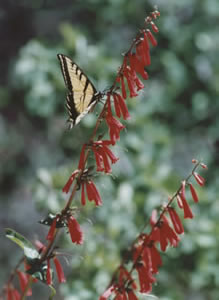 Firecracker red. Oh, say can you see, in the dawn’s early light, the flowers bursting forth along those rocky ramparts? The Eaton’s penstemon (Penstemon eatonii) is the Fourth of July equivalent in the wildflower world. The large, glossy green leaves are a stark contrast to the tubular, firecracker-shaped, and colored, flowers. You expect to hear an explosion every time the flowers open. The Bloom Boom. Named for Alvah Eaton, a 19th century plant collector, this wildflower attracts butterflies and hummingbirds to defuse the flowers. Firecracker red. Oh, say can you see, in the dawn’s early light, the flowers bursting forth along those rocky ramparts? The Eaton’s penstemon (Penstemon eatonii) is the Fourth of July equivalent in the wildflower world. The large, glossy green leaves are a stark contrast to the tubular, firecracker-shaped, and colored, flowers. You expect to hear an explosion every time the flowers open. The Bloom Boom. Named for Alvah Eaton, a 19th century plant collector, this wildflower attracts butterflies and hummingbirds to defuse the flowers.
Though many other May flowers add to this 64-crayon box of colors, I’ll stop while I’m ahead. I probably won’t give the color-inventing staffers a run for their jobs, but what a fun job that could be! And with the wealth of flowers in bloom in this May, there is no shortage for creativity or color schemes.
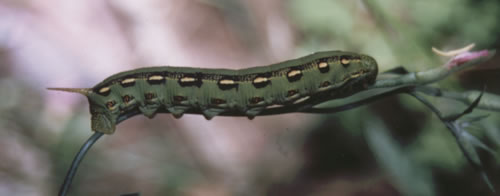
|



 Casper white. I’ve never seen a white ghost, but I have turned a few shades whiter after my ghostly encounters. Who was I gonna call? Maybe it’s too much this starched white that taints my color scheme. But for the white-flowered dwarf evening primrose (Oenothera caespitosa) whose paranormal blossoms light up the night, the color choice seems appropriate. Blooming from late afternoon into the morning hours (definite ghosting times), these sweet-scented flowers are laden with nectar to attract non-ghost-fearing pollinators like the white-lined sphinx moth.
Casper white. I’ve never seen a white ghost, but I have turned a few shades whiter after my ghostly encounters. Who was I gonna call? Maybe it’s too much this starched white that taints my color scheme. But for the white-flowered dwarf evening primrose (Oenothera caespitosa) whose paranormal blossoms light up the night, the color choice seems appropriate. Blooming from late afternoon into the morning hours (definite ghosting times), these sweet-scented flowers are laden with nectar to attract non-ghost-fearing pollinators like the white-lined sphinx moth. Often confused with their no-relation hummingbird look-alike, the sphinx moth zips around in the evening and uses its long proboscis to extract nectar from deep down within the flower’s throat. Sort of an invertebrate Dracula minus the fangs. At the same time, the flower’s long stamens powder the sphinx moth’s forehead with pollen. At the next nectar stop some of this pollen rubs or falls off onto the flower’s style; hence, the process of pollination has been bought for a few sweet drinks.
Often confused with their no-relation hummingbird look-alike, the sphinx moth zips around in the evening and uses its long proboscis to extract nectar from deep down within the flower’s throat. Sort of an invertebrate Dracula minus the fangs. At the same time, the flower’s long stamens powder the sphinx moth’s forehead with pollen. At the next nectar stop some of this pollen rubs or falls off onto the flower’s style; hence, the process of pollination has been bought for a few sweet drinks.  Firecracker red. Oh, say can you see, in the dawn’s early light, the flowers bursting forth along those rocky ramparts? The Eaton’s penstemon (Penstemon eatonii) is the Fourth of July equivalent in the wildflower world. The large, glossy green leaves are a stark contrast to the tubular, firecracker-shaped, and colored, flowers. You expect to hear an explosion every time the flowers open. The Bloom Boom. Named for Alvah Eaton, a 19th century plant collector, this wildflower attracts butterflies and hummingbirds to defuse the flowers.
Firecracker red. Oh, say can you see, in the dawn’s early light, the flowers bursting forth along those rocky ramparts? The Eaton’s penstemon (Penstemon eatonii) is the Fourth of July equivalent in the wildflower world. The large, glossy green leaves are a stark contrast to the tubular, firecracker-shaped, and colored, flowers. You expect to hear an explosion every time the flowers open. The Bloom Boom. Named for Alvah Eaton, a 19th century plant collector, this wildflower attracts butterflies and hummingbirds to defuse the flowers.